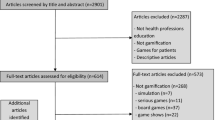Abstract
Introduction
While healthcare outcomes have improved significantly, the complex management of diseases in the hospitals has also escalated the risks in patient safety. Therefore, in the process of training medical students to be proficient in medical knowledge and skills, the importance of patient safety cannot be neglected. A new innovation using mobile apps gaming system (PAtient Safety in Surgical EDucation—PASSED) to teach medical students on patient safety was created. Students were taught concepts of patient safety followed by a gaming session using iPad games created by us. This study aims to evaluate the outcome of patient safety perception using the PASSED games created.
Methods
An interactive iPad game focusing on patient safety issues was created by the undergraduate education team in the Department of Surgery, Yong Loo Lin School of Medicine at the National University of Singapore. The game employed the unique touched-screen feature with clinical scenarios extracted from the hospital sentinel events. Some of the questions were time sensitive, with extra bonus marks awarded if the student provided the correct answer within 10 s. Students could reattempt the questions if the initial answer was wrong. However, this entailed demerit points. Third-year medical students posted to the Department of Surgery experienced this gaming system in a cohort of 55–60 students. Baseline understanding of the students on patient safety was evaluated using Attitudes to Patient Safety Questionnaire III (APSQ-III) prior to the game. A 20 min talk on concept of patient safety using the WHO Patient Safety Guidelines was conducted. Following this, students downloaded the apps from ITune store and played with the game for 20–30 min. The session ended with the students completing the postintervention questionnaire.
Results
A total of 221 3rd year medical students responded to the survey during the PASSED session. Majority of the students felt that the PASSED game had trained them to understand the processes of medical error (p < 0.001), that their understanding on patient safety issues improved (p = 0.007), and the training prepared them to prevent medical errors (p < 0.001). Many students also recognized the importance of error reporting, where they felt comfortable reporting errors committed by themselves (p < 0.001) or by other people (p < 0.001). They also felt comfortable discussing with the supervisor on medical errors (p < 0.001). Students responded that better teamwork will reduce medical errors (p = 0.003), and teaching teamwork skills will reduce medical errors (p = 0.002). After the PASSED session, students felt that patients could play an important role in preventing medical errors (p < 0.001). They felt that patient safety should be emphasized in undergraduate training (p = 0.024). The level of understanding about concepts of patient safety was also found to improve progressively from the 2nd posting to the 5th posting for both the pre-PASSED and post-PASSED intervention. The pre-PASSED scores for Posting 2 (3.59 ± 1.931), Posting 3 (4.11 ± 1.833), Posting 4 (4.84 ± 1.653), and Posting 5 (4.88 ± 1.642) were significantly higher than the post-PASSED scores for Posting 2 (4.46 ± 2.020), Posting 3 (5.17 ± 1.845), Posting 4 (5.88 ± 1.843), and Posting 5 (5.80 ± 1.843), respectively (p < 0.001).
Conclusion
Using iPad game (PASSED) to enhance the patient safety teaching has successfully improved the awareness and understanding of patient safety in clinical practice. This training model can be used to teach more senior medical students on the complexity of patient safety issues in medicine.





Similar content being viewed by others
References
Brennan TA, Leape LL, Laird NM, Hebert L, Localio AR, Lawthers AG et al (1991) Incidence of adverse events and negligence in hospitalized patients—results of the Harvard Medical Practice Study I. N Engl J Med 324:370–376
Patey R, Flin R, Cuthbertson BH, MacDonald L, Mearns K, Cleland J, Williams D (2007) Patient safety: helping medical students understand error in healthcare. Qual Saf Health Care 16:256–259
Wattanasoontorn V, Boada I, Garcia R, Sbert M (2013) Serious games for health. Entertain Comput 4:231–247
Walton M, Woodward H, Van Staalduinen S et al (2010) The WHO patient safety curriculum guide for medical schools. Qual Saf Health Care 19:11
Carruthers S, Lawton R, Sandars J, Howe A, Perry M (2009) Attitudes to patient safety amongst medical students and tutors: developing a reliable and valid measure. Med Teach 31:e370–e376
Nie Y, Li L, Duan Y, Chen P, Barraclough BH, Zhang M, Li J (2011) Patient safety education for undergraduate medical students: a systematic review. BMC Med Educ 11:33
Alper E, Rosenberg EL, O’Brien KE, Fischer M, Durning SJ (2006) Patient safety education at U.S. and Canadian medical schools: results from the, Clerkship Directors in internal medicine survey. Acad Med 2009(84):1672–1676
Leung GK, Patil NG, Ip MS (2010) Introducing patient safety to undergraduate medical students—a pilot program delivered by health care administrators. Med Teach 32:547–551
Leung GKK, Ang SBL, Lau TC, Neo HJ, Patil NG, Ti LK (2013) Patient safety culture among medical students in Singapore and Hong Kong. Singapore Med J 54(9):501–505
Philibert I, Friedmann P, Williams WT (2002) For the members of the ACGME work group on resident duty hours. New requirements for resident duty hours. J Am Med Assoc 288(9):1112–1114
Firth-Cozens J (2001) Cultures for improving patient safety through learning: the role of teamwork. Quality in Healthcare 10:ii26–ii31
Sutton G, Liao J, Jimmieson NL, Restubog SLD (2013) Measuring ward-based multidisciplinary healthcare team functioning: a validation study of the team functioning assessment tool (TFAT). J Healthc Qual 35(4):36–49
Moskowitz E, Veloski JJ, Fields SK, Nash DB (2007) Development and evaluation of a 1-day interclerkship program for medical students on medical errors and patient safety. Am J Med Qual 22(1):13–17
Funding sources
NUHS Innovative Clinical Education (NICE) Grant and Teaching Enhancement Grant (TEG) Learning Grant from Center for Development of Teaching and Learning, National University of Singapore.
Author information
Authors and Affiliations
Corresponding author
Appendix
Rights and permissions
About this article
Cite this article
Kow, A.W.C., Ang, B.L.S., Chong, C.S. et al. Innovative Patient Safety Curriculum Using iPAD Game (PASSED) Improved Patient Safety Concepts in Undergraduate Medical Students. World J Surg 40, 2571–2580 (2016). https://doi.org/10.1007/s00268-016-3623-x
Published:
Issue Date:
DOI: https://doi.org/10.1007/s00268-016-3623-x




